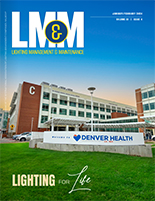For the past four years running, David Radulescu, Ph.D., has spoken on patent issues facing the LED lighting industry during the week of LightFair. These privately-hosted meetings have been well attended by LED lighting companies interested in learning more about the increasing threat of patent litigation to their businesses. Last Thursday, your humble editor sat in his most recent webinar. Dr. Radulescu discussed developments in IP litigation over the past year.
U.S. patent grants hit a 10-year high in 2019, with LED patent grants in 2020 projected to be near the level of 2019. In terms of LED patent assignees in 2019, Signify, Seoul Semiconductor, Ideal Industries Lighting, and Lumileds ranked at the top. Overall, U.S. patent litigation activity is up this year, with a projected 3,800 cases compared to 3,347 in 2019. 2019 to 2020 saw a shift in the top venue for patent disputes from the District of Delaware to the Western District of Texas. At the PTAB, IPR institution rates continue to drop to a projected all-time low of 55% in 2020.
View the slides here.
Dr. Radulescu spoke about the LED patent litigation landscape: Who Is Suing and Who Is Being Sued. 2020 is projected to see 68 infringement suits, compared to 76 in 2019. Notable suits in 2019 and 2020 include an ITC investigation brought by Lighting Science Group against lighting and LED chip manufacturers, two ITC investigations brought by UC Santa Barbara, suits brought by Philips/Signify, and a number of suits brought by companies looking to license their portfolios, and non-practicing entities.
Over the past three years, Signify/Philips’ EnabLED Campaign has continued with the company bringing four suits in 2019, two of which are still active. These come on the heels of Signify’s 2017 ITC investigation, which originally asserted five patents against seven respondents. A hearing was held in August 2018 on three patents against three respondents (the rest of the respondents had either settled or defaulted), with the administrative law judge finding a violation with respect to one patent in a December 2018 ruling. However, the full ITC reversed that finding last July, holding that Signify failed to prove that the accused products were representative and failed to prove infringement. Signify appealed to the Federal Circuit but then dismissed that appeal in October 2019. Notably, Signify continues to litigate against one of the respondents it took to trial, Satco, in a suit in the Eastern District of New York, asserting seven patents (4 old, 3 new).
Dr. Radulescu reviewed other notable licensing program campaigns, including Lighting Science Group (LSG), CAO Lighting, Lynk Labs, TOGGLED/iLumisys, and UC Santa Barbara. LSG’s ITC investigation was split into three investigations, two of which were withdrawn by LSG one of which went to trial in March 2020. The administrative law judge found no violation of the two remaining asserted patents covering LED chips, and the full ITC affirmed that decision on October 1. CAO Lighting filed a recent spate of suits against GE, OSRAM/LEDVANCE, and Feit directed to LED bulbs that is currently pending in Delaware and California. Another notable case was successive ITC investigations brought by UC Santa Barbara who asserted patents directed to filament LED bulbs against several retailers. After withdrawing the first investigation, UC Santa Barbara recently filed a second investigation in August 2020 against IKEA, GE Lighting, Feit, Satco, and Home Depot, with 2 patents from the first investigation and 3 new patents. Dr. Radulescu then provided a review of current non-practicing entity campaigns brought by Bench Walk, Heavy Duty Lighting, LedComm, and Lexington Luminance.
Dr. Radulescu ended the webinar with a discussion of how Covid-19 has impacted patent litigation. Overall, the number of new cases filed has not been impacted and judges have been moving cases along through discovery. Access to physical court buildings has been limited, hearings and motion arguments are being held telephonically or over Zoom. Jury trials were initially delayed, but are now being held either live or remotely. And the need for in-person depositions is fundamentally changing given the ease and convenience of taking depositions over Zoom.
View the slides here.
Radulescu’s Webinar Last Week Focused on Patent Issues Facing the Lighting Industry
- by Randy Reid
- October 5, 2020



